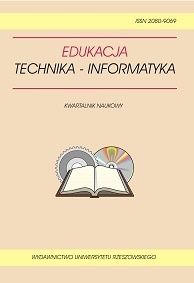Neurodydaktyczne aspekty procesu rozwiązywania testowego zadania matematycznego na podstawie badań eyetrackingowych
Słowa kluczowe:
neurodydaktyka, badania eyetrackingowe, rozwiązywanie zadania matematycznego, głębokość przetwarzania informacjiAbstrakt
Contemporarily the necessity of regarding the knowledge of brain structure and functions in the didactic processes is more and more frequently discussed. Neurodidactics, as a cross-disciplinary science is engaged in the learning and education process which is based on the results of research on brain functioning. One of the non-invasive methods that can provide us with knowledge on brain functioning is the research carried out with an eye-tracker, a device used for tracing eyeball movements of a tested person. This paper will present a part of the research in which the eye-tracking technology has been used. The aim of the presented research was an attempt to analyse the depth of information processing by a pupil during solving a mathematical test task. The research results point to certain characteristic pupils’ behaviour while making decision concerning the choice of an answer marked by them.Pobrania
Opublikowane
2015-09-30
Jak cytować
ROŻEK, B., BŁASIAK, W., ANDRZEJEWSKA, M., GODLEWSKA, M., KOZUBOWSKI, P., ROSIEK, R., SAJKA, M., STOLIŃSKA, A., & WCISŁO, D. (2015). Neurodydaktyczne aspekty procesu rozwiązywania
testowego zadania matematycznego na podstawie badań
eyetrackingowych. Journal of Education, Technology and Computer Science, 13(3), 202–208. Pobrano z https://journals.ur.edu.pl/jetacomps/article/view/6457
Numer
Dział
WIDEODYDAKTYKA. STAN OBECNY I PERSPEKTYWY ROZWOJU
Licencja
Prawa autorskie (c) 2015 Journal of Education, Technology and Computer Science

Utwór dostępny jest na licencji Creative Commons Uznanie autorstwa – Na tych samych warunkach 4.0 Miedzynarodowe.

